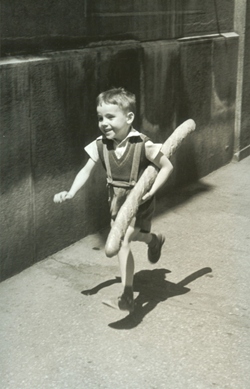There is a large black and white photograph on the wall of my local coffee shop attributed to Willy Ronis. It is slightly blurred, and yet the photo does everything that a photojournalist would want of his shots. The boy is running with the long French bread loaf, and you can almost read his anticipatory thoughts as he runs home with the bread.
In many ways, Willy Ronis is the epitome of the French photojournalism school, being a photographer who probably showed post WWII French life better than anyone. Even in the photo of the boy, the ‘prop’ of the French bread puts the photograph directly into France.
Ronis was actually born in Paris, of a Jewish refugee father from Odessa, and a Lithuanian refugee mother. The principles of photography came from his father, who had opened a photography studio in Montmartre. The business offered three primary services: portraiture, retail and retouching of prints for other photographers, and the young Willy Ronis was recruited to assist in retouching portraits.

However, the boy’s early interest was music and he hoped to become a composer, but when his father died from cancer, he had to concentrate on maintaining the photography studio and the portraiture business.
The work of other now famous photographers such as Alfred Stieglitz and Ansel Adams influenced Ronis, who closed the family studio to allow him to concentrate on reportage.
Ronis met other photographers of his generation, including David “Chim” Seymour (AKA David Szymin) who would become a good friend. In the 1930’s he also came to meet Robert Capa (then known by his given name André Friedmann) and Henri Cartier-Bresson. The four of them, along with George Rodger, founded the, now celebrated, Magnum agency. With Cartier-Bresson, Ronis belonged to Association des Écrivains et Artistes Révolutionnaires, and remained a left wing socialist.
The advent of WWII interrupted his photographic career, but in 1946 he joined Robert Doisneau, Brassaï and others at the Rapho Agency. Ronis was the first French photographer to work for LIFE Magazine. His reputation was such that in 1953 Edward Steichen included his work in an exhibition at the Museum of Modern Art titled Five French Photographers – the other four being Henri Cartier-Bresson, Robert Doisneau, Izis and Brassaï.
In 1957 Ronis was awarded the Gold Medal at the Venice Biennale, but his photographic career was waning. He began teaching part-time that year due primarily to the growing competition within the field of photo reportage. By 1968 he was teaching full time and over the next eight years taught at the School of Fine Arts in Avignon, Aix-en-Provence and Saint Charles, Marseilles.
Some of his most celebrated photographs include Provençal Nude taken in 1936 of his wife, the Communist militant painter Marie-Anne Lansiaux (1910 – 91). This photograph, taken in a house that he and Anne Marie had just bought in Gordes, showed Marie-Anne washing at a basin with a water pitcher on the floor and an open window through which the viewer can see a garden, and this is noted for its ability to convey an easy feeling of Provençal life. The photograph was a “huge success”; Ronis would comment, “The destiny of this image, published constantly around the world, still astonishes me.” Later in her life, Ronis photographed Marie-Anne suffering from Alzheimer’s disease, sitting alone in a park surrounded by autumn trees, to show the loneliness of an Alzheimer’s sufferer.
Ronis continued to live and work in Paris, although he stopped photography in 2001, since he required a cane to walk and could not move around with his camera. He also worked on books for the Taschen publishing company.
In 2005-2006 when he was then 95, the City of Paris presented “Willy Ronis in Paris”, a large retrospective show of his work, that had a huge success with over than 500,000 visitors.
Willy Ronis died at age 99, on September 12, 2009, but his photographs live on, even on the wall of my local coffee shop! It is worth your while looking up some of his photographs and you will see the eye of the master.




